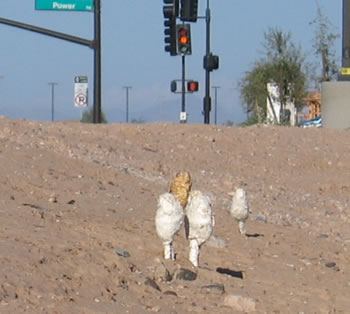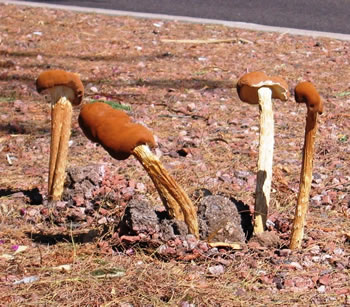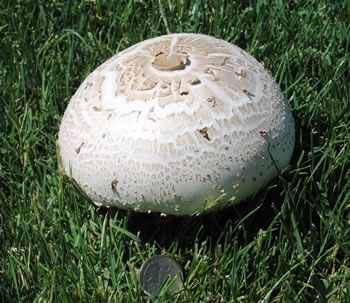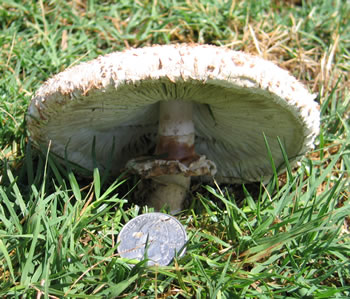Common AZ fungi in the desert
The desert would probably be the last place you would go for a mushroom foray, and you would be hard pressed to ever find any edible fungi there. Yet, the desert is full of fungi, and most desert plants rely heavily on their help. Of course, I'm talking about the kinds that don't interest a mushroom hunter: microscopic mycorrhizae and fungi that dwell in leaf tissues called endophytes. Still, the vast majority of Arizonans live in the desert, and there are a handful of common mushroom producing fungi that share our local environs.
Our dry climate favors fungi that require less water, and incorporate dessication in their strategy. These would be the stalked puffballs. One other mushroom, far less expected but quite common, occurs in the urbanized desert. Described below are three commonly found urban desert mushrooms.
The Desert Shaggy Mane
- Podaxis pistillaris
The desert shaggy mane bears close resemblance to the far more moist true shaggy mane; hence, the name. Stalked puffballs are well known for their specialization to dry environments, and they intentionally dry out to form brittle, papery "lollipops" filled with a mass of brown spores. When ready, a small disturbance, even wind, will break apart their outer layer and release their spores.
P. pistillaris is a very common resident of urban desert environments. It prefers sandy areas, and can appear in very large numbers in disturbed locations, such as those under construction or development. The most common locations are the edges of roads and in medians, where they recieve drip irrigation water and gain nutrients from leaf litter.

Giant Stalked Puffball
- Battarrea phalloides and Battarrea diguetii
B. phalloides is probably the tallest mushroom in existance. When fully grown, it can be up to 2 feet tall! If you don't know what you're looking at, you may mistake it for a bleached branch stuck in the ground.
B. phalloides has much in common with P. pistillaris. It shares similar habitats, appears in similar time periods, and has a similar life cycle. Yet, B. phalloides is far less common; you should be quite pleased to find one.
There are two giant stalked puffballs commonly found in the Sonoran desert. The best way to tell them apart is by the puffball section: B. phalloides has an unblemished head, while B. diguetii is arrayed with small holes when mature.

Green Gilled Parasol
- Chlorophyllum molybdites
You wouldn't expect to find a large, fleshy, moist mushroom in the middle of the desert. Yet, the green gilled parasol mushroom thrives in urban habitats and can be found in large numbers when it appears.
Still, these mushrooms don't appear without an ample amount of help from us. C. molybdites is highly heat tolerant, and occurs throughout the Southwest, but it requires plenty of moisture to survive. It gets all it can ask for by living in the irrigated soils of lawns, golf greens, drainage areas, etc. C. molybdites primarily lives off of grass clippings, and often occurs in fairy rings.
The green gilled parasol is easy to identify because it is the only large classical mushroom to be found in the low desert. However, it closely resembles edible Agaricus such as the meadow mushroom. This is a big problem, as C. molybdites is poisonous. In fact, C. molybdites is the leading cause of mushroom poisoning in the Southwest.
Properties:
- Large, scaly, greenish-white cap
- Ring present on the stem, often loose and can be slid up / down
- Gills pale when immature but turn green as spores mature
- Found most often on irrigated, mowed lawns
-- Note --
Because C. molybdites occurs on lawns as a result of irrigation and grass thatch, it is not limited to the urbanized desert. I have also found it on lawns in the Flagstaff area.

